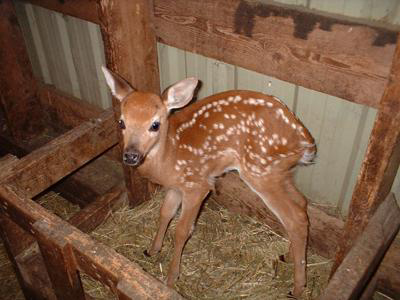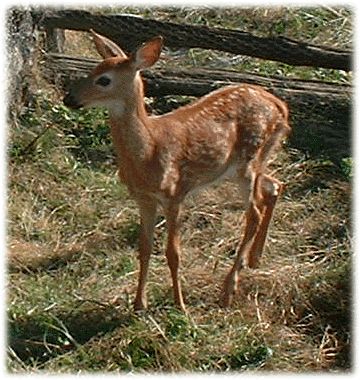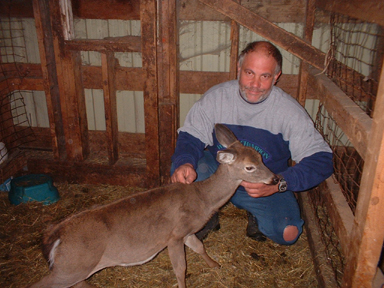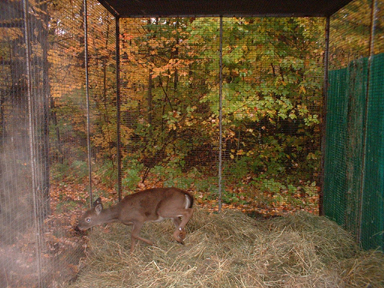Annie
 This summer we had the privilege of raising a white-tailed deer. A neighbour
found her wandering in the road near his friend's farm, and after going
back and checking on her several times through the day to see if she had
moved to a safer place, he decided she was truly abandoned and took her
home. Knowing we had dairy goats he asked if their milk would be suitable
for her, and if we could take care of her for a few days. She weighed just
10 pounds when she came to us and could have been no more than a couple
of weeks old. I called a local vet to check that goat milk was an adequate
substitute. She took to the goat's milk well, and within a few days was quite
settled with her foster family.
This summer we had the privilege of raising a white-tailed deer. A neighbour
found her wandering in the road near his friend's farm, and after going
back and checking on her several times through the day to see if she had
moved to a safer place, he decided she was truly abandoned and took her
home. Knowing we had dairy goats he asked if their milk would be suitable
for her, and if we could take care of her for a few days. She weighed just
10 pounds when she came to us and could have been no more than a couple
of weeks old. I called a local vet to check that goat milk was an adequate
substitute. She took to the goat's milk well, and within a few days was quite
settled with her foster family.
In fact our very first call had been to the relevant authorities responsible for wildlife in this area, who suggested we leave her in the forest at the back of our property. This seemed to us a rather odd suggestion, as we had made it clear that she had been found several kilometers away, but we learned later that this was the normal advice given. There are no local facilities for orphan deer, and as they are so plentiful, neither the funding nor motivation to provide any. Typically a triplet or injured fawn would be left by the mother and would be food for the wolves, coyotes and vultures. Presumably the authorities do not interefere with this unless the animal is endangered. While I understand the reasoning behind this, it was quite beyond us to do it. We realised we'd be keeping her a while, but agreed not to name her. It didn't last. She aquired the name "Annie" because, well, she was an orphan!
 We began looking for a permanent home for her right from the start, but
it was no easy matter. Local deer farmers informed me that regulations prevented
them from taking an animal from the wild for breeding stock. Local zoos
had no places for her. We tried various avenues through rescue and humane
organizations, and finally found a provincial park with a small facility
for deer. The park is ultimately under the same auspices as the office I
initially called, albeit in a different county. Obviously a referral system
needs to be in place.
We began looking for a permanent home for her right from the start, but
it was no easy matter. Local deer farmers informed me that regulations prevented
them from taking an animal from the wild for breeding stock. Local zoos
had no places for her. We tried various avenues through rescue and humane
organizations, and finally found a provincial park with a small facility
for deer. The park is ultimately under the same auspices as the office I
initially called, albeit in a different county. Obviously a referral system
needs to be in place.
We found ourselves needing to become experts on deer care very quickly. Fortunately the internet allows for expertise to be shared readily, and many helpful people advised us on nutrition and health care. Although we think of deer as forest animals, they actually graze on pasture and browse among brush in clearings just like goats, and then chew the cud in the peace of the evening among the trees. We soon saw her preferences among the grasses and other greenstuffs she found in her run or in her bucket of veggies, her favourite treat being carrots. As we weaned her from milk she started eating a good quantity of mixed grains also. She began to get a little too chubby for a deer and we had to ration her grain!
Needless to say she had many visitors during the summer, and had
almost constant attention from our children and friends. She also became
close to several of our cats, and enjoyed terrifying chickens by jumping
out of "nowhere" from the long grass and then chasing them.  In her first pen her neighbours were turkeys, and I'm not sure who was
the most perplexed at trying to identify the species next door. She soon
outgrew that pen and we built a bigger one with higher fences. Nevertheless
one day she decided to jump right over it and disappeared for two full days.
We searched everywhere for her. Finally I was just gardening when a car
screeched to a halt on the road out front and the driver shouted "LOOK! There's
a deer in your field!". I called "Annie!" and she came bounding towards me
for hugs and kisses, much to the utter shock and amazement of the driver!
"It's OK" I called "she's a friend!"
In her first pen her neighbours were turkeys, and I'm not sure who was
the most perplexed at trying to identify the species next door. She soon
outgrew that pen and we built a bigger one with higher fences. Nevertheless
one day she decided to jump right over it and disappeared for two full days.
We searched everywhere for her. Finally I was just gardening when a car
screeched to a halt on the road out front and the driver shouted "LOOK! There's
a deer in your field!". I called "Annie!" and she came bounding towards me
for hugs and kisses, much to the utter shock and amazement of the driver!
"It's OK" I called "she's a friend!"
At the end of October she was ready to leave us and go to her new home. At the park she will be living with other deer who cannot be released into the wild due to being "too tame", after imprinting on humans. We will really miss having her around, but we know she has a good, safe home away from hunters and predators. Being in a protected compound her expected lifespan increases from about 3 years to anything up to 16. She will have all the benefits of the forest without the risk of starvation in winter.
 While we were at the park we had a chance to meet the other deer and also see the rest of the animals there. These include owls, wolves, bears, turkeys, pheasants, hawks, foxes, and coyotes.
While we were at the park we had a chance to meet the other deer and also see the rest of the animals there. These include owls, wolves, bears, turkeys, pheasants, hawks, foxes, and coyotes.
Annie's temporary compound. She will stay here until she has grown enough to run with the other deer in the park.